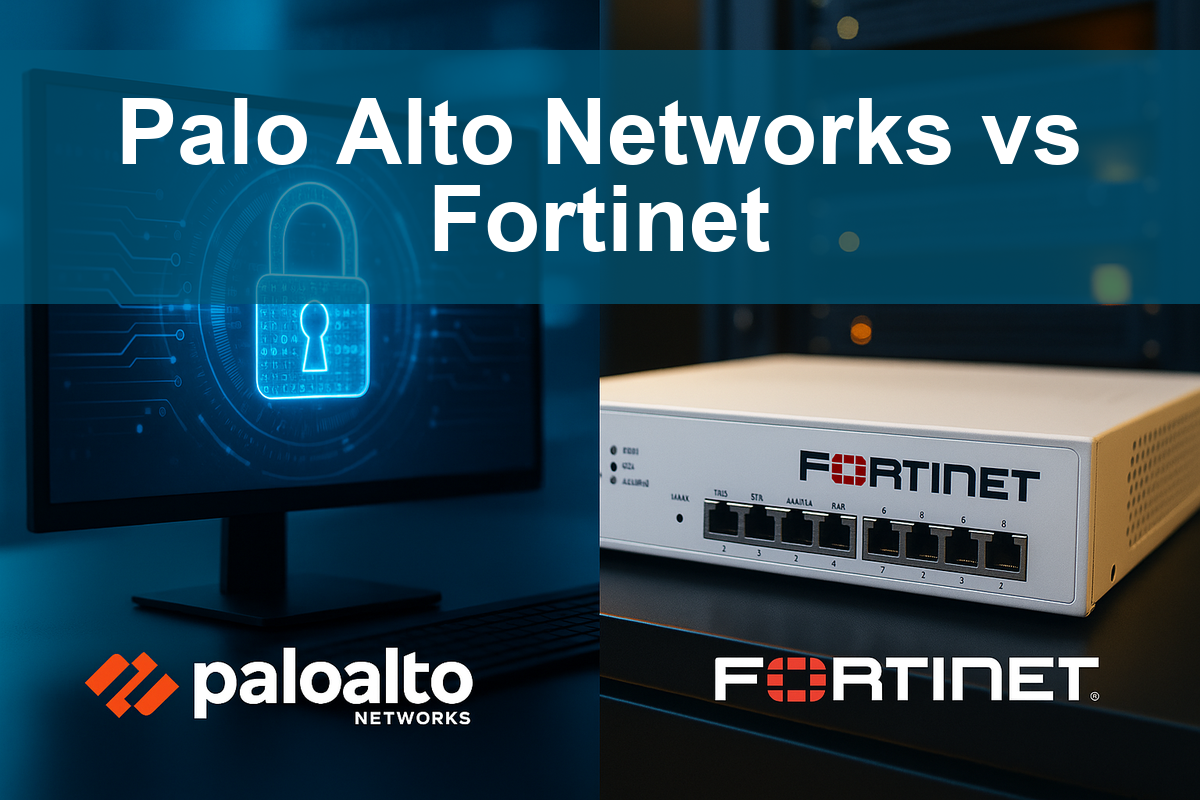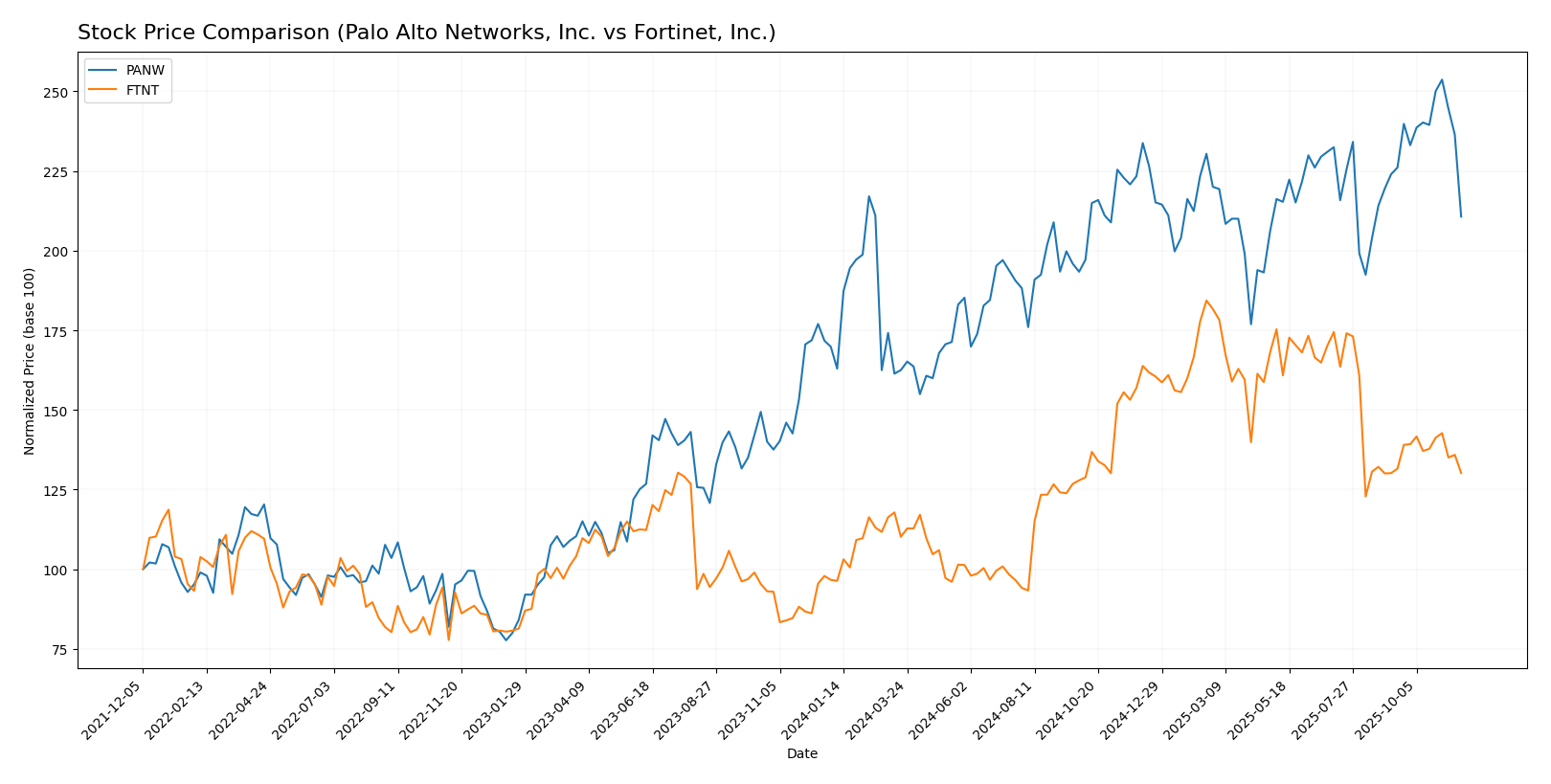In today’s rapidly evolving tech landscape, cybersecurity is paramount, making companies like Palo Alto Networks, Inc. (PANW) and Fortinet, Inc. (FTNT) critical players in the Software – Infrastructure industry. Both firms are leading innovators, offering comprehensive security solutions that cater to businesses across various sectors. By analyzing their market strategies and growth potential, I aim to help you identify which company may be the most compelling investment opportunity. Let’s delve into their strengths and weaknesses to find the best fit for your portfolio.

Table of contents
Company Overview
Palo Alto Networks, Inc. Overview
Palo Alto Networks, Inc. is a leading cybersecurity company headquartered in Santa Clara, California. Founded in 2005, its mission is to protect the digital landscape by providing comprehensive security solutions. The company offers a wide range of products, including advanced firewalls, threat intelligence, and cloud security services, catering primarily to medium to large enterprises and government entities. With a market capitalization of approximately $122.3B, Palo Alto Networks leverages innovative technology to address the evolving threats in the cybersecurity ecosystem. Their robust approach incorporates a combination of hardware, software, and subscription services to ensure holistic protection for clients across various industries, including finance, healthcare, and telecommunications.
Fortinet, Inc. Overview
Fortinet, Inc., established in 2000 and based in Sunnyvale, California, is another key player in the cybersecurity sector. With a market cap of around $60.2B, Fortinet’s mission is to deliver broad, integrated, and automated security solutions that safeguard the digital world. The company provides an extensive array of products, such as the FortiGate security appliances, endpoint protection, and secure networking solutions. Fortinet serves a diverse customer base, including sectors like education, retail, and government, ensuring that both large enterprises and smaller organizations can benefit from its advanced security technologies.
Key Similarities and Differences
Both Palo Alto Networks and Fortinet operate within the cybersecurity software infrastructure industry, offering a variety of security solutions tailored to enterprises. However, Palo Alto Networks focuses heavily on cloud security and threat intelligence, while Fortinet emphasizes integrated networking and security functions through hardware and software. This distinction in product offerings reflects their unique strategies in addressing the complex needs of their clients in the ever-evolving cybersecurity landscape.
Income Statement Comparison
The following table summarizes the most recent income statements for Palo Alto Networks, Inc. (PANW) and Fortinet, Inc. (FTNT), highlighting key financial metrics.
| Metric | Palo Alto Networks (PANW) | Fortinet (FTNT) |
|---|---|---|
| Revenue | 9.22B | 5.96B |
| EBITDA | 1.94B | 2.20B |
| EBIT | 1.60B | 2.08B |
| Net Income | 1.13B | 1.75B |
| EPS | 1.71 | 2.28 |
Interpretation of Income Statement
In the most recent fiscal year, Palo Alto Networks (PANW) experienced a significant revenue increase to 9.22B, reflecting a robust growth trajectory. Meanwhile, Fortinet (FTNT) also showed improvement with a revenue of 5.96B. PANW’s net income was 1.13B, indicating a solid bottom line, although it represents a deceleration compared to previous years. In contrast, FTNT’s net income of 1.75B reflects effective cost management, resulting in improved margins. The overall trends indicate that both companies are growing, but FTNT is exhibiting stronger profitability, suggesting it may be a more stable investment option at this time.
Financial Ratios Comparison
In this section, I present a comparative analysis of the most recent financial metrics for Palo Alto Networks, Inc. (PANW) and Fortinet, Inc. (FTNT).
| Metric | PANW | FTNT |
|---|---|---|
| ROE | 14.49% | 116.83% |
| ROIC | 5.67% | 27.05% |
| P/E | 101.43 | 41.38 |
| P/B | 14.70 | -98.34 |
| Current Ratio | 0.89 | 1.47 |
| Quick Ratio | 0.89 | 1.39 |
| D/E | 0.04 | -2.14 |
| Debt-to-Assets | 0.014 | 0.137 |
| Interest Coverage | 414.30 | 90.17 |
| Asset Turnover | 0.39 | 0.61 |
| Fixed Asset Turnover | 12.56 | 4.41 |
| Payout ratio | 0 | 0 |
| Dividend yield | 0% | 0% |
Interpretation of Financial Ratios
The analysis reveals that Fortinet exhibits a significantly higher return on equity (ROE) of 116.83%, indicating strong profitability relative to shareholder equity, compared to Palo Alto’s 14.49%. However, Palo Alto has a much higher price-to-earnings (P/E) ratio, suggesting overvaluation or growth expectations. Both companies maintain a low debt-to-equity (D/E) ratio, indicating conservative leverage. The current and quick ratios for Fortinet suggest a more favorable short-term liquidity position compared to Palo Alto, which shows potential concerns about its immediate financial obligations.
Dividend and Shareholder Returns
Both Palo Alto Networks (PANW) and Fortinet (FTNT) do not pay dividends, a strategy likely driven by their focus on growth and innovation. Instead, they prioritize reinvesting profits into research and development, positioning themselves for long-term value creation. Both companies also engage in share buybacks, which can support share price and enhance shareholder returns. This lack of dividends, combined with strategic reinvestment, suggests a commitment to sustainable growth that aligns with shareholder interests.
Strategic Positioning
Palo Alto Networks (PANW) and Fortinet (FTNT) are leading players in the cybersecurity software market, with PANW holding a market cap of approximately $122.3B and a robust portfolio centered on threat prevention and cloud security. Meanwhile, FTNT, valued at around $60.2B, is recognized for its integrated security solutions and competitive pricing strategies. Both companies face significant competitive pressure from emerging technologies and established firms, necessitating continuous innovation to maintain market share and address technological disruptions.
Stock Comparison
Over the past year, Palo Alto Networks, Inc. (PANW) and Fortinet, Inc. (FTNT) have exhibited notable price movements, reflecting varying trading dynamics that are vital for investors to consider.

Trend Analysis
Palo Alto Networks, Inc. (PANW) has experienced a price increase of 24.05% over the past year, indicating a bullish trend. However, the recent trend shows a slight decline of -5.94% from September 7, 2025, to November 23, 2025. The highest price during this period was 220.24, while the lowest was 134.51. The trend is characterized by deceleration, and the standard deviation of 20.4 suggests significant volatility.
Fortinet, Inc. (FTNT) has outperformed with a price change of 34.73% over the past year, also reflecting a bullish trend. In the recent analysis period, the price has remained relatively stable with a minimal change of 0.04% from September 7, 2025, to November 23, 2025. The highest price recorded was 111.64, with a low of 56.51. Similar to PANW, FTNT shows deceleration in trend momentum, accompanied by a lower volatility indicated by a standard deviation of 16.18.
Both companies have demonstrated strong performance over the last year, but recent trends suggest careful monitoring as both stocks exhibit signs of deceleration.
Analyst Opinions
Recent analyst recommendations indicate a cautious but positive outlook for both Palo Alto Networks (PANW) and Fortinet (FTNT). Analysts rated PANW with a “B,” highlighting strong performance in discounted cash flow and return on equity metrics, while citing concerns about its price-to-earnings ratio. Fortinet received a “B+” rating, praised for its superior returns on equity and assets. Overall, the consensus for both companies leans towards a “buy” for the current year, reflecting confidence in their growth potential amidst market challenges.
Stock Grades
In this section, I present the latest stock ratings for two companies in the cybersecurity sector: Palo Alto Networks, Inc. (PANW) and Fortinet, Inc. (FTNT).
Palo Alto Networks, Inc. Grades
| Grading Company | Action | New Grade | Date |
|---|---|---|---|
| HSBC | Downgrade | Reduce | 2025-11-21 |
| Goldman Sachs | Maintain | Buy | 2025-11-21 |
| Bernstein | Maintain | Outperform | 2025-11-20 |
| DA Davidson | Maintain | Buy | 2025-11-20 |
| Cantor Fitzgerald | Maintain | Overweight | 2025-11-20 |
| Rosenblatt | Maintain | Buy | 2025-11-20 |
| Wedbush | Maintain | Outperform | 2025-11-20 |
| BTIG | Maintain | Buy | 2025-11-20 |
| WestPark Capital | Maintain | Hold | 2025-11-20 |
| Piper Sandler | Maintain | Overweight | 2025-11-20 |
Fortinet, Inc. Grades
| Grading Company | Action | New Grade | Date |
|---|---|---|---|
| Jefferies | Maintain | Hold | 2025-11-06 |
| RBC Capital | Maintain | Sector Perform | 2025-11-06 |
| Rosenblatt | Maintain | Neutral | 2025-11-06 |
| Mizuho | Maintain | Underperform | 2025-11-06 |
| TD Cowen | Maintain | Hold | 2025-11-06 |
| Barclays | Maintain | Equal Weight | 2025-11-06 |
| Baird | Maintain | Neutral | 2025-11-06 |
| JP Morgan | Maintain | Neutral | 2025-11-06 |
| UBS | Maintain | Neutral | 2025-11-06 |
| Piper Sandler | Maintain | Neutral | 2025-11-06 |
Overall, PANW shows a mixed trend with some analysts downgrading their ratings while others maintain a positive outlook. In contrast, FTNT’s grades remain stable, with all grading companies opting for a “maintain” action, indicating a cautious sentiment among analysts.
Target Prices
The consensus target prices from analysts indicate a positive outlook for both Palo Alto Networks, Inc. (PANW) and Fortinet, Inc. (FTNT).
| Company | Target High | Target Low | Consensus |
|---|---|---|---|
| Palo Alto Networks, Inc. | 250 | 157 | 228.83 |
| Fortinet, Inc. | 110 | 67 | 88.5 |
The analysts expect Palo Alto Networks (PANW) to reach a consensus target price of 228.83, significantly above its current price of 182.9. For Fortinet (FTNT), the target consensus is 88.5, also higher than its current price of 78.855. This suggests favorable growth potential for both companies, although investors should remain cautious and consider market conditions.
Strengths and Weaknesses
The following table outlines the strengths and weaknesses of Palo Alto Networks, Inc. (PANW) and Fortinet, Inc. (FTNT) based on the most recent data.
| Criterion | Palo Alto Networks, Inc. (PANW) | Fortinet, Inc. (FTNT) |
|---|---|---|
| Diversification | Moderate | High |
| Profitability | 12.3% Net Profit Margin | 29.3% Net Profit Margin |
| Innovation | Strong in cybersecurity | Strong in networking |
| Global presence | Present in multiple regions | Strong in various regions |
| Market Share | 8% in cybersecurity | 7% in cybersecurity |
| Debt level | Low (0.04 Debt to Equity Ratio) | Moderate (0.67 Debt to Equity Ratio) |
Key takeaways indicate that while both companies are strong in innovation and global presence, Fortinet shows significantly higher profitability and a more diversified product range. In contrast, Palo Alto Networks maintains a lower debt level, which may appeal to risk-averse investors.
Risk Analysis
In the following table, I outline the key risks associated with Palo Alto Networks, Inc. (PANW) and Fortinet, Inc. (FTNT), two prominent players in the cybersecurity sector.
| Metric | Palo Alto Networks (PANW) | Fortinet (FTNT) |
|---|---|---|
| Market Risk | Moderate | Moderate |
| Regulatory Risk | Low | Low |
| Operational Risk | High | Moderate |
| Environmental Risk | Low | Low |
| Geopolitical Risk | Moderate | Moderate |
In synthesizing the risks, I find that both companies face moderate market and geopolitical risks, driven by fluctuations in the cybersecurity landscape and global political tensions. Operational risk is notably higher for Palo Alto Networks due to aggressive growth strategies that could strain resources.
Which one to choose?
When comparing Palo Alto Networks (PANW) and Fortinet (FTNT), both companies exhibit strong fundamentals, but FTNT appears to have a slight edge. FTNT showcases a higher gross profit margin of 80.6% compared to PANW’s 73.4% and a superior net profit margin of 29.3% versus 12.3%. Additionally, FTNT’s current ratio of 1.47 indicates better liquidity compared to PANW’s 0.89, suggesting a more favorable short-term financial position.
While both stocks have bullish trends with FTNT showing a 34.7% price increase over the past year versus PANW’s 24.1%, the analysts’ ratings reflect FTNT with a B+ compared to PANW’s B.
For growth-oriented investors, FTNT may be the more attractive option, while those prioritizing established performance may consider PANW. However, both companies face risks such as intense competition in the cybersecurity sector and potential valuation pressures.
Disclaimer: This article is not financial advice. Each investor is responsible for their own investment decisions.
Go further
I encourage you to read the complete analyses of Palo Alto Networks, Inc. and Fortinet, Inc. to enhance your investment decisions:



